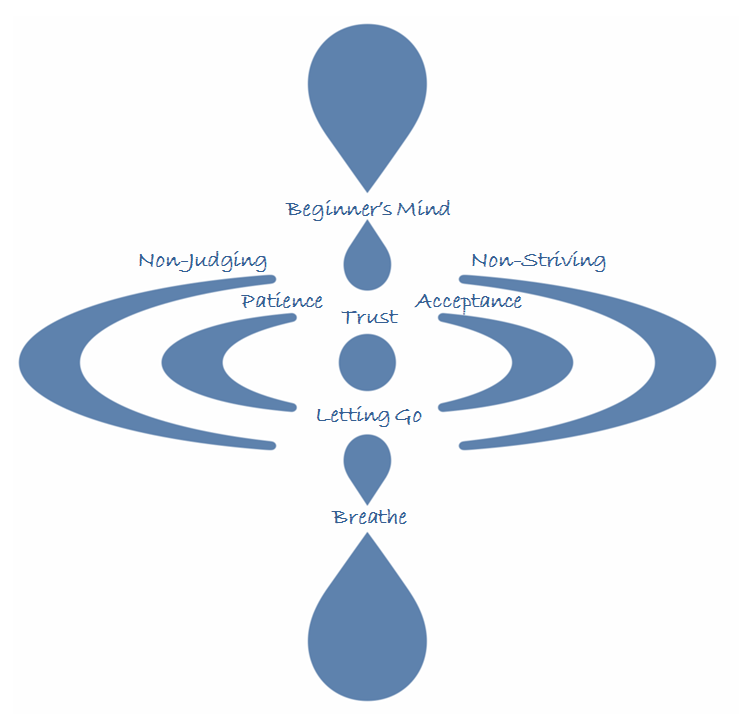In today’s fast-paced world, finding a moment of calm and clarity can be a challenge. With the demands of work, family, and the constant buzz of technology, the concept of mindfulness has emerged as a powerful antidote to our scattered thoughts and relentless distractions.
The mindfulness symbol is at the heart of this practice, serving as a visual reminder of the profound journey towards living in the present moment. Let’s explore the essence of mindfulness, the symbolism it carries, and how it can transform your life.
What Does It Mean To Be Mindful?
Mindfulness is a practice of being fully present in the moment. It’s the art of directing your attention to the here and now, letting go of worries about the past or anxieties about the future. Mindfulness means experiencing life as it unfolds, free from judgment and preoccupation.
It involves paying attention to our thoughts and feelings without judgment, becoming aware of the world around us, and fostering a deep sense of self-awareness.
Picture a moment when you savor the taste of a perfectly ripe strawberry, feel the warmth of the sun on your skin, or truly listen to a friend without your mind wandering. These are instances of mindfulness, moments of pure awareness and presence.
What Is The Mindfulness Symbol?
The symbol features a water droplet and its mirrored reflection. Two droplets are positioned vertically on top, with their mirrored counterparts at the bottom, and a circular droplet in the center. These droplets represent time, with the top ones symbolizing the future, the bottom ones representing the past, and the center droplet signifying the present moment.
The symbol also includes two equal rings, resembling ripples on water, which represent space. Together, these elements convey the idea of being fully present in the here and now [2].
Where Does The Mindfulness Symbol Come From?
The mindfulness symbol was created by a Lithuanian graphic artist named Cibulskisa. It was designed to visually represent the concept of mindfulness and has since been embraced by various individuals and organizations as a powerful reminder to stay present in the moment.
The symbol is open-source and free to use, allowing it to spread widely and serve as a universal reminder of mindfulness [1]. It has gained widespread acceptance among psychologists, spiritual leaders, and professionals.
How Does The Mindfulness Symbol Represent The Present Moment?
The mindfulness symbol effectively represents the present moment through its visual elements. The vertical arrangement of the droplets symbolizes time, with the top droplets representing the future and the mirrored droplets at the bottom representing the past. The center droplet, positioned between the two sets, represents the present moment.
This arrangement signifies the idea of being centered in the present, free from the distractions of past regrets or future worries. The symbol’s design encourages individuals to focus on the here and now, embracing the experience of the present moment with equanimity [1].
How To Use The Mindfulness Symbol In Your Life
Incorporating the mindfulness symbol into your daily life can be a powerful way to anchor your mindfulness practice. Here are a few ways you can integrate this symbol into your routine:
1. Visual Reminders
Place images or representations of the mindfulness symbol in locations where you often find yourself distracted or stressed. Whether it’s on your desk, hanging on your wall, or even as your screensaver, the symbol can serve as a gentle nudge to pause, take a deep breath, and re-center your thoughts.
2. Meditation Focus
During meditation sessions, you can visualize the mindfulness symbol in your mind’s eye. As you breathe in and out, imagine the unending loop and the central point. This visualization can deepen your meditation practice, grounding you in the present moment.
3. Mindful Journaling
Incorporate the mindfulness symbol into your journaling routine. Drawing or sketching the symbol as you reflect on your day can be a powerful way to remind yourself to stay in the present moment while processing your thoughts and feelings.
4. Mindful Eating
During meals, you can place a small image of the mindfulness symbol on your dining table. It can serve as a reminder to savor each bite, appreciating the flavors, textures, and the act of nourishing your body.
5. Mindfulness Tattoo

People get mindfulness tattoos as a permanent reminder to live in the present moment and embrace mindfulness. These tattoos are often personalized with additional elements like quotes or other meaningful symbols. Consider getting the mindfulness symbol as a tattoo, serving as a permanent reminder to stay present and cultivate mindfulness.
6. Jewelry
Jewelry, such as pendants and rings, is a fashionable way to carry a symbol of mindfulness with you, serving as a daily reminder to stay present.
7. Art and Home Decoration
The symbol can be found in various art forms, from paintings to sculptures. It is also a popular choice for interior decoration, adorning walls, cushions, and other home accessories to create a serene atmosphere.
You can use Mindfulness symbol as Wall Art to hang a drawing or painting of the mindfulness symbol on your walls as a visual reminder to be present and practice mindfulness.
Incorporate the mindfulness symbol into a tapestry or fabric art piece, creating a visual representation of mindfulness in your living space.
8. Meditation and Mindfulness Apps
Many meditation and mindfulness apps feature the Mindfulness symbol, using it as their logo or incorporating it into their interface to encourage users to stay present during their practice.
9. Business and Brands:
Some companies and brands incorporate the mindfulness symbol into their logos or marketing materials, aligning themselves with the values of mindfulness and inner peace.
10. Personal Accessories
You can find the Mindfulness Symbol on personal accessories like clothing, phone cases, and even on water bottles, allowing individuals to express their commitment to mindfulness in their daily lives.
11. Phone or Computer Wallpaper:
Set the mindfulness symbol as your wallpaper to see it regularly and prompt moments of mindfulness throughout your day.
The mindfulness symbol is widely shared on social media platforms, often accompanied by inspirational quotes or messages, creating a sense of community around the practice of mindfulness.
Print out the symbol and share it with your community, whether at work, school, or social gatherings, to spread awareness of mindfulness.
The contemporary usage of the mindfulness symbol emphasizes its universal appeal and its ability to resonate with people seeking a more mindful and balanced way of living. It has transcended cultural and religious boundaries to become a symbol of the present moment’s significance in our increasingly busy lives.
How To Practice Mindfulness
Incorporating the mindfulness symbol into your daily life is just one aspect of practicing mindfulness. Here are some practical steps to help you embrace mindfulness fully:
1. Start with Your Breath
Begin by paying close attention to your breath. Focus on the sensation of each inhale and exhale. When your mind wanders, gently bring it back to your breath. This simple act can quickly anchor you in the present moment.
2. Body Scan
Take time to scan your body, noticing any areas of tension or discomfort. As you breathe, focus on these areas, and with each exhale, let go of the tension.
3. Observe Your Thoughts
Mindfulness involves observing your thoughts without judgment. Let them come and go, like clouds passing in the sky. Recognize that your thoughts are not you, and you don’t need to attach to them.
4. Engage Your Senses
Fully engage your senses in your surroundings. Notice the colors, sounds, and textures. Bring your full awareness to the present moment, immersing yourself in the beauty of the here and now.
5. Cultivate Gratitude
Practice gratitude by acknowledging the things you are thankful for in your life. This can shift your focus from what’s lacking to what you already have, fostering contentment.
6. Mindful Movement
Engage in activities like yoga, tai chi, or even a simple mindful walk. Pay close attention to the physical sensations and movements as you go about these activities, further grounding you in the present moment.
Final Thoughts On The Mindfulness Symbol And Practicing Mindfulness
The mindfulness symbol serves as a powerful reminder to be present in the moment and cultivate mindfulness in our lives. By incorporating the symbol into our daily routines and practicing mindfulness techniques, we can experience greater clarity, peace, and well-being. Embracing the present moment allows us to let go of past regrets and future worries, leading to a more fulfilling and balanced life.
Frequently Asked Questions (FAQs)
Is there a symbol for equanimity?
Yes, there is a symbol for equanimity in Buddhism known as the “Uroboros.” It’s often represented as a snake or dragon eating its tail, signifying balance, serenity, and equanimity in the face of life’s ever-changing nature.
What is the practice of mindfulness?
The practice of mindfulness involves being fully present in the moment, observing thoughts, emotions, and sensations without judgment. It promotes self-awareness, inner peace, and mental clarity through various techniques like meditation and deep breathing.
What is mindful awareness meditation?
Mindful awareness meditation is a technique that cultivates mindfulness by focusing on the present moment. It involves paying attention to one’s breath, bodily sensations, or a chosen point of focus. This practice enhances awareness and reduces mental chatter.
What are the 7 pillars of mindfulness?
The Seven Pillars of Mindfulness are core principles that guide the practice. They include mindfulness of the body, feelings, mind, mental objects, speech, action, and livelihood. These pillars promote awareness and ethical conduct, leading to a more mindful life.
What are the 5 concepts of mindfulness?
The Five Aggregates, or Skandhas, are the foundational concepts of mindfulness in Buddhism. They encompass form, sensation, perception, mental formations, and consciousness. Understanding these aggregates helps individuals deconstruct their experiences and gain deeper insight into their nature.

